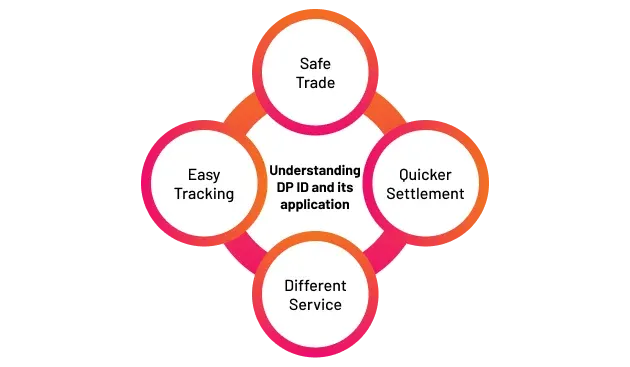What is DP ID in the Demat Account?
The DP ID full form refers to Depository Participant Identification. It is an eight-digit unique code that is assigned to a Depository Participant by an authorised depository such as NSDL or CDSL. It is the first eight digits of the 16-digit Demat account number, with the rest constituting the customer ID. The DP ID acts as an important element in securities trading. It helps ensure accurate tracking and secure transfer of securities between Demat accounts, thereby maintaining transparency and authenticity in all trading activities. This article explains what DP ID in Demat account is.
Example of DP ID in Demat Account
The following example helps get a clear understanding of DP ID in a Demat account and a way to recognise it from a Demat account number
As per fundamentals, DP ID + Beneficiary ID = Demat ID
- For instance, take the CDSL Demat account number 123567888664422 as an illustration. Here, the first eight numbers stand in for the DP ID (12345678), while the last eight numbers (88664422) stand in for the customer ID or beneficiary ID.
- The NSDL Demat account number will show up as IN12345678664422. Your nation is identified by its first two letters, which are India. The country code and the next six numbers make up the DP ID. Thus, IN123456 is the DP ID, and 78664422 is the beneficiary or customer ID.
Table of Content
- Example of DP ID in Demat Account
- Understanding DP ID in NSDL and CDSL
- Understanding DP ID and Its Applications
- What is the Purpose of the DP ID in a Demat Account?
- Finding Demat Account Number on the BlinkX App
- Conclusion
Understanding DP ID in NSDL and CDSL
The two central depositories regulated by the Securities and Exchange Board of India (SEBI) include the National Securities Depository Limited (NSDL) and the Central Depository Services Limited (CDSL). When you open a Demat account, a welcome letter from either NSDL or CDSL will be sent with a 16-digit Demat account number that includes the DP ID.
In the case of CDSL, the Demat account number is a 16-digit numeric combination, and this number is also termed the Beneficiary Owner ID or BO ID. Whereas, NSDL Demat account numbers start with the "IN" prefix followed by 14 digits. The first eight digits in both formats denote the DP ID allotted by the respective depository to the depository participant.

Understanding DP ID and Its Applications
DP ID plays a vital role in ensuring secure and efficient securities transactions within the Demat account. This eight-digit unique identifier serves multiple functions that enhance the trading experience for investors.
- Efficiency: The DP ID enables the smooth and secure transfer of securities between Demat accounts, ensuring accuracy in trading operations.
- Quick Settlement: As a component of the Demat account number, the DP ID facilitates quick electronic settlement of all transactions conducted through the Demat account.
- Access to Services: Once the request for DP ID is accepted, the depository grants access to various services, including e-voting and pledges, expanding investment management capabilities.
- Transaction Tracking: The DP ID makes transaction tracking easy by ensuring transparency within the trading framework and providing an easy way to monitor securities.
- Security: The DP ID ensures that no unauthorised third party can get access to the Demat account. This acts as an important layer of safety over ownership.
The eight-digit code adds an identification tag to the depository participant involved, ensuring that transactions move to the correct DP for processing. This systematic approach maintains the integrity of the trading system whilst providing investors with reliable and secure access to their securities.
What is the Purpose of the DP ID in a Demat Account?
After understanding the DP ID meaning, let's understand its purpose in a Demat account:
- The DP ID helps identify Demat accounts that are opened with different Depository Participants within the same depository.
- It combines with the client ID to create a unique Demat account number, similar to how an International Financial Services Centres Authority (IFSC) code works for bank accounts.
- The DP ID format varies between CDSL and NSDL, ensuring accurate identification of the account holder.
- It helps maintain the security of electronic holdings by recording all transactions under the correct Depository Participant.
- It is essential for monitoring and managing securities smoothly during electronic trading and transfers.
- The DP ID identifies the specific Depository Participant (DP) with whom the investor has opened the Demat account.
Finding Demat Account Number on the BlinkX App
Follow the steps mentioned below to find the Demat account number on the BlinkX App.
Step 1: Launch the BlinkX app
Step 2: Click on the ‘Account’ section
Step 3: After that, click on profile in the top-right corner of the screen
Step 4: Find the Demat account number mentioned below the customer ID.
Conclusion
The DP ID serves as an essential component of the Demat account system. It is an eight-digit unique identifier that ensures secure and efficient securities trading. It forms the first eight digits of the 16-digit Demat account number and facilitates various critical functions, including transfer of securities, quick transaction settlement, access to depository services, transparent transaction tracking, and protection against unauthorised access. A clear understanding of the DP ID also helps investors manage their holdings using a reliable Stock Market App.
Recent Articles
Related Articles
Press Release
- BlinkX launches ItsATraderThing Campaign
- blinkX Introduces 'Options Watchlist' to Empower Traders with Real-Time Insights
- BlinkX Enhances Trading with 24/7 Customer Support Capabilities
- Unlocking Seamless Trading: Introducing “Order Slicing” For The FnO Market
- A Game-Changer for Traders: Introducing Horizontal Watchlists